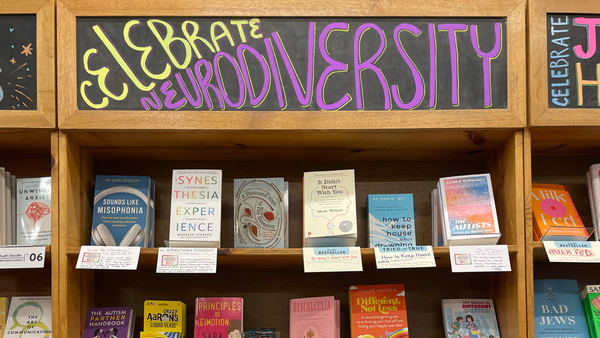By Ben Breaux, Bened Life Contributing Writer
As a nonspeaking Autistic, I feel it is of utmost importance that non-, minimal- and unreliably speaking Autistics have equal rights, opportunities, and voices in society. This includes access to regulation devices, tools, or anything that helps each individual. So often people with autism face stigma and hardships. With regulation tools, this stress can be minimized. So many hearts don’t receive the support they need. As you read, I hope you will come to understand why many Autistics resort to their devices, like iPads, when stressed and dysregulated.
Dysregulation is especially challenging for people who can’t easily communicate. Having an iPad and other ways to self-regulate are so important for me, but outsiders often don’t understand this. This is not just my own personal opinion – these claims are supported by data from a survey I created with input and perspectives from 47 other Autistics. A published scientific study of Autistic students came to a similar conclusion too.
What is dysregulation, why do iPads help, and what do dozens of Autistics have to say about it, in their own words? Read on to find out.
What Is “Dysregulation” for an Autistic?
For me (and I have heard the same from many of my Autistic peers), dysregulation is often a twofold situation and manifests as me being unable to control or regulate the (1) physical actions of my body and/or my (2) emotional status. Though I may fully know there is a necessary or desired task to do or complete, my body and/or brain often decides to go rogue and go on its own misguided adventure!
What Can “Dysregulation” Look Like?
While this differs from person to person, I may very well suddenly run across a room pell-mell in huge and thunderous strides for no reason and no end goal, or cry woefully and uncontrollably with seemingly no precursor event. Or, and this is my most horrible fear, I may become physically aggressive with a nearby person due to being dysregulated.
While this may sound a bit amusing, it is actually a highly frustrating and, at times, even a debilitating state to be in.
So, let’s explain this a bit more scientifically:
I-ASC is a global organization for Nonspeaking and Neurodivergent Individuals. In a piece entitled “Thinking Through Dysregulation”, noted and respected “Spelling to Communicate” (S2C) practitioners Lakshmi Rao Sankar and Debbie Spengler directly address the topic of dysregulation as such:
There are two parts of the brain involved in dysregulation: the cortical area and the subcortical area. The cortical area is the “thinking” part of the brain while the subcortical is the “limbic” part, the “area where emotions reside.” The cortical area is active when we feel “in control and regulated” and is involved in “planning and purposeful movement.” The subcortical area involves movement that is NOT planned and “no conscious thinking” happens here. This area is “important for survival;” think about your nervous system’s fight or flight defense response to danger. When active, the subcortical part of the brain “takes over and is extremely difficult to override” to get back to the cortical brain. It is especially difficult for people who struggle with “receiving and filtering sensory information.”1
I so concur with the information and insight shared in this article. I want to be in control of my body’s movements like most people are. For instance, there is often the expectation of my sitting still and/or being quiet. Honestly, this is generally not a realistic or even achievable goal for me, particularly without access to some very valuable and needed accommodations and supports. Without those accommodations and supports, I’m more likely to be dysregulated and unable to control my body.
Dysregulation also interferes with my ability to communicate. Since I am nonspeaking, I have to use AAC to communicate. “AAC'' is Augmentative and Alternative Communication. For me, this can be an iPad app with simple button options or, more often, pointing to letters on a letterboard with a trained Communication/Regulation Partner (CRP). I like the letterboard more in most cases, as it gives me full access to my individual vocabulary and my personal flair in my words can be conveyed. In any moment of my communication, whether it’s spelling or typing, I must be regulated in order to accurately point to the letters I need to convey my words.
How to Stay Regulated Using an iPad

My iPad has been a major contributor to my regulation. So many Autistics struggle with emotional regulation as well as sensory overload and the omnipresent attempt to feel connected to their bodies. Something familiar, such as an iPad, can partially help achieve this.
A major component in regulation is consistency and predictability, which the iPad provides. In addition to this, music and its mere presence are major aids for me and for others, another helpful feature of iPads.
Music for Regulation
Music is my grounding method. It is comforting in every moment of life. Music can calm me, energize me, and bring me out of a slump. I rely on music for keeping regulated and use it to get through each and every day. It helps me to be less overwhelmed by all the stimulating factors coming at me like a horrible storm, hence why it is so important that I have access to music throughout the day.
I mainly listen to music on my iPad so I can use YouTube to listen to a variety of songs, as I have a video for every mood and regulation need. I may also use Apple Music to listen to some of my most beloved and connected to songs.

ASMR for Regulation
Accessing through my iPad, I also often utilize ASMR videos on YouTube for regulation. ASMR (Autonomous Sensory Meridian Response) is “a tingling, static-like, or goosebumps sensation in response to specific triggering audio or visual stimuli.”2
For me, this can be crisp or squishy sounds while someone creates artwork with multi-color slime and beads. I find them quite calming and grounding for me when I’m dysregulated. I experience ASMR from watching the satisfying fit of Legos or puzzles, or games involving bright colors. Many are “children's level” videos and games, but I accept the comfort from hearing or watching as crucial to my regulation in order to be in control of my body to get important responsibilities accomplished. Other orderly things like dominos and roller coasters in these videos give me some mental respite as well.
“Survey Says…”
Most Autistics Use iPads to Help with Regulation
In order to more widely support my theory of iPads and iPhones as regulation tools I created a survey to seek personal responses and input from nonspeaking Autistics (which encompasses nonspeaking, “minimally speaking, and unreliably speaking individuals).
The survey, “iPads/Tablets and/or Phones as Regulation Tools”, was placed on a variety of social media platforms, and I received 47 responses.3 While this was not an official research study, my results should not be ignored, because to hear from 47 individuals from this often-unrepresented community is significant and hardly ever done.
The ages of the 28 respondents who chose to report their age were between 5-46 years old, with the mean and median age being 22 years old. Of the 27 respondents who chose to report their gender identities, 15% identified as female, 59% as male, and 26% as non-binary/gender-nonconforming.
85.1% of the respondents said they use AAC for communication. Some forms of AAC included use of letterboards/keyboards, dedicated AAC device/tablet or phone app/videos on device, and ASL/communication cards/noises and gestures.
When asked if they use any device for COMMUNICATION reasons, 80.4% said YES.

When asked if they use any device for REGULATION reasons, 95.7% responded YES.

While it is true that devices are an incredible accommodation tool for communication and as an AAC device, that is not the only reason they’re important.
Outside Opinions vs. Lived Experience
I hear often from neurotypicals around me how I should not always be on my iPad and hear them draw conclusions about me based on how I use it. I have been told by trusted teachers and other professionals that it is not legitimate to use an iPad as a regulation tool. I am not sure why they feel they have the necessary personal insight and/or experience to make such overreaching comments. It is presumptuous to make this kind of a statement without being Autistic themselves.
My energy levels fluctuate considerably from day-to-day due to various health issues. My iPad provides consistency in my hectic life and helps boost my energy levels. When my iPad dies, my energy levels tend to dip. The music makes my life brighter and keeps me awake.
When I asked respondents if they ever felt judged for using their devices, 55.3% said yes.
- Many explained this judgment coming in the form of labels (“iPad kid,” “lazy,” “stupid,” “socially rude,” “addicted”). They felt that people think of the device user as not intelligent or not having “more than basic needs.”
- Many found this judgment to cause them to feel ashamed or depressed, and felt their typed words were not as valued as words spoken out loud.
- Respondents shared that others often focus on the amount of “screen time” rather than the positive aspects of how the device helps the person, like self-regulation, language acquisition and growth, and access to communication.
Word cloud of negative phrases from the survey used to describe individuals using regulation devices and how it made the respondents feel:

Conversely, I asked the respondents to explain how the devices can be helpful when dysregulated, and I found many responses focused on the FAMILIARITY of the device. The familiarity helps create a calming, reliable, and REGULATING experience for the user.
Respondents shared that there is repetition in the physical exercise of flipping through familiar pages or videos which helps to reduce anxiety. This “specific and predictable sensory input” helps many to be productive after getting through the dysregulation of “senses and emotions.”
Many users also felt a “sense of control” especially knowing they had access to communication and regulation in a low-demand way. It also creates a focus to help block out overwhelming sensory input, stay “centered,” and be able to concentrate. Devices offer a variety of tools to help both down-regulate and up-regulate arousal and can address “visual and/or auditory and/or tactile needs for a given person” to get to the level of “arousal needed to regulate.”
Up-regulation refers to the activation of the nervous system, while down-regulation refers to the process of returning to a state of relaxation and calm.
Word cloud of POSITIVE phrases from the survey used to describe regulation devices’ benefits:

iPad: Regulation Tool or Distraction?
I hoped to emphasize the crucial role devices play as an accommodation, not only as a communication device, but more often as a regulation tool. I asked the respondents how often they utilized their device as a communication tool versus as a regulation tool and their responses showed a drastic difference.
While 46.8% of the respondents said they use a device for COMMUNICATION all the time or often, 83% of the respondents said they use a device for REGULATION all the time or often. This furthers my point above. I believe Autistics should be listened to regarding these statistics. My peers and I have spent much time being ignored because of preconceived notions about politeness and social etiquette. It is time we change that.
Since there is much conjecture around the idea that devices are distracting or dysregulating to Autistics, I thought it best to address this concern by asking the following question: Do you ever feel that your iPad/tablet/phone is distracting or dysregulating?
NONE of the respondents said that devices are ALWAYS distracting or dysregulating. 71.8% said they are sometimes or rarely distracting or dysregulating and 23.9% said they never are.

So, if this is the case, are breaks from devices beneficial or do they cause more harm?
When asked this question, 56.5% of the respondents said they NEVER need a break from their device and always have their device with them and 37% said breaks were needed every so often. Many explained ways in which a positive break from their device can be initiated but also times when breaks can be negative or harmful to the person.

The most common response explained how dysregulating it can be if the device is abruptly removed from the person using it, but that the iPad itself doesn’t cause this dysregulation. This could be if the break is initiated by someone who (as one respondent said) “doesn’t recognize the supports needed to transition away from something and doesn’t use validative declarative spoken and/or gestural language to help with transition” or if the device dies/needs charge. This kind of lead-in to a break from a device can cause the person to have a hard time transitioning to the next activity without it and cause feelings of “unregulation” [dysregulation], “restlessness,” and “agitation,” especially without a familiar source to help “regulate emotions” or not being able to communicate as well.
Some spoke to when their device breaks can actually be a positive asset. The consensus was that when the break is not abrupt and not forced by someone else, it can help the person transition to other activities or move to another regulating activity. These breaks, when initiated correctly, had other positive influences, such as giving the eyes a rest, a pause from social media and the stress of so many “options and decisions”, and even breaks from loops while using the device.
Additionally, when the device glitches while communicating, that can be dysregulating, so a break gives the option to use other communication options that are not linked to the device.
When my iPad dies, my reactions can vary. Any dysregulation that stems from my iPad abruptly dying is when I am actively using it. I am most okay with my iPad being dead when I have other regulation tools at my disposal. This can look like being on a car ride or having my spiral toy.
The bottom line from the responses was that breaks from devices affect the person negatively if the breaks are forced, nonconsensual, or abrupt. The breaks can be positive for the person when they are not abruptly brought on and are not forced (if the person chooses to take a break from the device), and/or when the person is regulated and/or in a comfort zone (like maybe at home) and has other regulating options available to them.
What Scientists Say
Can an iPad serve an important role not just in communication but also in regulation? My survey of non- or minimally-speaking Autistics strongly suggests it can, and is even more important for regulation than communication.
A 2023 study of Autistic schoolchildren at two schools in the UK came to a similar conclusion when interviewing their teachers and parents. This particular study stood out to me because it looked at iPad use in real-world settings and considered multiple viewpoints (educators and parents).
In this research study, “Using iPads for the social communication and emotional regulation of autistic pupils: an exploration of key stakeholders' perspectives and practices,” the researchers found that “the use of free-flow, interest-based iPad activities can reduce stress levels and challenging behavior in pupils with autism, and therefore, facilitate inclusion.”4
While iPads were not used for lessons or for communication in one of the schools, “all educators used iPads to calm pupils down and control challenging behavior.” The researchers concluded that iPads can be beneficial for social communication, reduced anxiety levels for emotional regulation, and could help the motivation to learn for Autistic students.
Me & My iPad: Regulation Partners
My own experience with dysregulation stemming from iPads follows what everyone in the survey has said. I don’t usually take breaks from my iPad unless I am going to the bathroom, showering, or about to go to sleep. I greatly benefit from my iPad, and my family and CRPs are very understanding of this accommodation. Breaks are not necessary for me. I would say they are more neutral than anything, though I do sympathize with those who benefit from breaks.
A while ago, I used to have my iPad locked on my Proloquo communication app for meetings, school classes and tests, and workouts/purposeful movement exercises. At the time this was beneficial because it allowed me to fully concentrate on the task at hand. Nowadays, I don’t need it locked as often, though sometimes my CRPs remind me to focus if I get distracted. When my iPad is locked, my mind tends to wander to other things rather than what I need to work on.
However, as I mentioned previously, this wasn’t always the case. The unlocked iPad during work is a more recent habit. Though I’m unsure what brought on this change, my CRPs are flexible and listen to my needs. Regardless, it has never inhibited my ability to talk with others even if it seems I’m not paying attention. In fact, it helps me keep my interactions regulated. Overall, I can’t say my iPad has been anything but useful and regulating.
One recommendation from a mother of a 9-year-old Autistic boy really resonated with me. She said:
“We should allow children the chance to use apps when they are dysregulated in order to allow children to find/learn their own methods of regulation within the communication systems they have access to… [V]isual timers, drawing, even meditation apps might be helpful to include for children… It would be so beneficial if we could expand from ‘just a communication system’ into a system we use for both regulation and communication.”

How to Help Others Regulate
Now, how can YOU help Autistics stay regulated and feel comfortable, particularly AAC users?
- First, presume competence.
- Don’t talk down to non-speaking individuals. We are not non-thinking just because we do not talk.
- Don’t assume that we want to solely talk about our disabilities, because we are so much more than that.
- Treat us like human beings, and we can communicate in our own ways and connect that way.
- If someone uses a letterboard like myself or any other communication tool, allow them to finish their words without guessing or interrupting.
- Talk to the AAC-user, not the CRP. We can hear and understand everything you say. It may take me longer to communicate, but know I’m working hard and self-regulating to do it.
- If I mess up, it’s just like if you stutter or mistype – it happens. I’m not perfect.
- If you notice me stimming or using my iPad or not making eye contact with you or moving away from you, know I’m self-regulating and working hard to communicate with you.
- Respect and patience are most important. Trying to stay regulated can be really difficult, frustrating, and tiring. I need lots of support and understanding.
I need someone who I trust with me during a sensory overload episode. It helps to know I’m in a safe environment both physically and with that person. The person must stay calm and stay away from me. I need space immediately, then calm, soft touch is okay. The person can try to create an environment with decreased lighting and noises, and I tend to like having a blanket on me.
It helps when someone reminds me of my breathing. It also helps me to identify and write out things, like four things I see, three things I hear, two things I feel, etc. This process helps me stop hyperfocusing on my sensory overload and to actually regulate my breathing as it makes me connect again with the world around me. Then, talking about what happened once I’m calm lends to a learning moment and helps me shuffle through my thoughts and feelings.
Conclusion
Ultimately, I want people to listen to actual Autistics, as we have the only opinions that matter regarding Autistic issues. Nonspeakers and those who use AAC are so rarely listened to. The phrase, “nothing about us without us” should be heard and known by all. I can only hope that my words can make an impact, that I will be not only listened to and believed but understood.
I am also hoping that the information presented and expressed here is taken seriously and with as much regard as it should be as it is a collective statement from the voices of many who know themselves best.

About the author
Ben Breaux is a 24-year-old nonspeaking Autistic from Northern VA. He has written many articles for Autism and Disability Advocacy groups both in the US and worldwide, and is a very proud representative for the nonspeaking community on several advocacy boards and committees, both in the state of VA and nationally. He is currently working towards a High School diploma via "ACCESS," an online academic and support program for Alternative Learners. He strives daily to show the world that a disability will not hold him – or others like him – back.
Cited Refences:
- Thinking Through Dysregulation. I-ASC. Accessed September 6, 2024. https://i-asc.org/thinking-through-dysregulation/
- What ASMR means: How it works and why it's popular. Nebraska Medicine. Accessed September 6, 2024. Last updated April 26, 2022. https://www.nebraskamed.com/neurological-care/asmr-videos-are-exploding-online-but-what-is-asmr-and-does-it-work
- iPads as Regulation Tools Survey. Accessed September 6, 2024. https://docs.google.com/forms/d/1ABJATtHr9KrvGRXLD08jPSVbNubReSgEFdPlB0b7fd4/edit?usp=forms_home&ths=true
- Achtypi, A. et al. (2023) Using iPads for the social communication and emotional regulation of autistic pupils: an exploration of key stakeholders' perspectives and practices. Br. J. Special Ed. 50(2), 238-257.








12 comments
Thank you Ben for this article. It helps me understand how iPads help regulate. I’m just now starting training in the Spellers Method as a new practitioner and I needed to know this going in. I like the four things you see, three things you hear, two things you feel technique as well. Do you have any advice for me as a new practitioner that you didn’t already mention in your article?
This article was so enlightening. I am supportive to a non clinically diagnosed autistic adult, male who never expresses his true emotional feelings, but, admits privately to me his frustrating ability to effectively communicate. He spends little time communicating except for essential needs to get exactly what he needs or to get things done (for you and others) which he is extremely efficient at. He recently
discovered emotional web sites and has been flooding my cells phone and others (close to him) with an overload of kind and caring emotional excerpts strangely from out of the blue. It’s like things he has always wanted to say but couldn’t. It’s as if he has found an outlet to express himself. I’m sorry but I just always felt he was emotionally absent. You can’t responded to that email that I provided because it doesn’t work. But, you are definitely correct about the devices effectively used by autistic individuals and I appreciated your article immensely. Thank you.
Ben, thank you so much for writing this piece. As a mom of two young non-speakers, your words and insights are incredibly helpful and valuable for me to read and learn from. I can’t wait to read your future articles! Thank you so much for sharing!
Thanks so much for this beautiful piece. This helps me understand my the world of my son way better. Wow! I wish all autistic parents could read this.
Great article Ben! I will be sharing with family and friends to help facilitate understanding regarding my son’s iPad use. Loved the mix of lived experience and data.